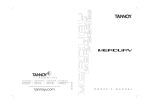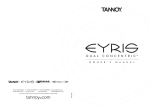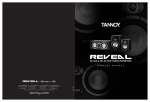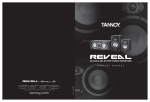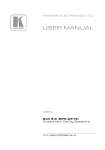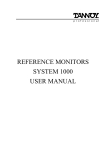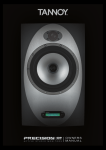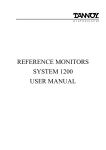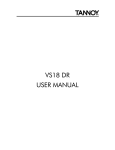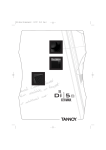Download Precision 6 User Manual
Transcript
T: +44 (0) 1236 420199 F: +44 (0) 1236 428230 E: [email protected] Tannoy North America T: (519) 745 1158 F: (519) 745 2364 E: [email protected] Tannoy Deutschland T: (04102) 888 393 F: (04102) 888 959 E: [email protected] Tannoy adopts a policy of continuous improvement and product specification is subject to change. 6481 0415 Tannoy United Kingdom 6 & 8 PASSIVE STUDIO MONITORS O W N E R S M A N U A L CONTENTS 2.1: UNPACKING AND VISUAL CHECKS 1.0: INTRODUCTION 2.0: THE BASICS 3.0: INSTALLING & POSITIONING 2.1 2.2 2.3 2.4 2.5 Unpacking and visual checks Preliminary recommendation Connecting your speakers Observing polarity Power Amplifiers 3.1 5.1 Surround Monitoring 3.2 Bass Ports 3.3 Equalisation The Precision 6 are packed in pairs and the Precision 8 is packed singly. To remove the speakers from the carton without damage open the end flaps fully and bend them right back. Turn the package upside-down on the floor and lift the carton vertically upwards to leave the speakers resting on their packing tray. Inspect each speaker for signs of transit damage. Nothing on or in your speakers should rattle about. In the unlikely event of damage having occurred, inform the carrier and the supplier. Keep all the packaging as this will show evidence of excessive handling forces. It is also a good idea to keep the packaging if possible for future transportation. 2.2: PRELIMINARY RECOMMENDATION Initially we would like to give a word of warning on high sound levels, which these speakers are capable of generating over sustained periods of time. Levels over 95 dB for 8 hours per day will eventually cause permanent hearing loss. Because Tannoy monitors have very low levels of time, amplitude and frequency distortion it is not always obvious that the sound level is high while working with them. For continuous exposure we recommend the occasional use of a sound level meter capable of integrating the sound level over a period of exposure according to noise control standards. This should be used just to check that noise levels are always within safety limits. 4.0: PRECISION 6 AND 8 DIMENSIONS 2.3: CONNECTING YOUR SPEAKER 5.0: PERFORMANCE DATA The types of cable used to connect the speakers to the power amplifier will marginally affect the sound. The cross-sectional area of the cable should be large enough so as not to affect the damping factor, generally a cable with a cross-sectional area of 2.5 mm2, or greater is recommended. 6.0: TECHNICAL SPECIFICATIONS 7.0: SERVICING 7.1 7.2 7.3 7.4 Cabinet finish Driver removal Crossover List of spare parts 8.0: WARRANTY 9.0: DECLARATION OF CONFORMITY The lower the resistance of the cable between the amplifier and the speakers, the better the damping factor acting on the speaker. This has been covered in every audio magazine that has ever been written about speakers, so we won’t beat it to death here. You don’t need to buy speaker wire that costs as much as your speakers to get some benefit from wire size, select a finely stranded speaker cable, and dress the cable ends to prevent "hairs" or stray conductors from shorting across the terminals. If your amplifier will not directly accept that size of cable, you can trim down the cable size at the amplifier end. Ensure that the binding post retaining nuts are screwed down firmly without stripping or over tightening them. 2.4: OBSERVING POLARITY You already know about connecting the positive terminal on the amplifier to the positive terminal on the speakers, and ensuring that both channels are "in phase" by checking to ensure that there’s more bass with both speakers on and not less bass. Absolute polarity is a bit trickier to confirm. Absolute polarity is the maintenance of a positive pressure wave from the microphone capsule to the listening room. A kick drum, for instance, has the drum skin whacked by the foot pedal, and it pushes the air, which pushes the microphone diaphragm, which goes through the electronics and should eventually come out of the speakers as a positive pressure wave, which should have the speaker cones moving towards you, just like the drum skin. It turns out that you can’t trust a conventional recorded source to test this because there is no way to confirm that absolute polarity was maintained, it can even change from track to track. This isn’t a trivial thing, especially when you’re using a true stereo microphone setup, or trying to accurately place things in your mix. This is something that should be rigorously checked with every microphone and every signal line in a studio, but the first step would be to use the kick drum test described above with a few microphones. If you don’t believe it can make a difference, set up a little test using a mix you know and flip the polarity of both channels at the same time, while listening to the same program...imaging, vague imaging, imaging, vague imaging. Hear-Believe! 1.0: INTRODUCTION Thank you for purchasing Tannoy Precision Monitors. 2.5: POWER AMPLIFIERS Designed and manufactured by Tannoy and incorporating new Dual Concentric™ designs these monitors are suitable for desk-top or 5.1 surround situations at near and mid field monitoring positions. Unlike discrete systems with separate low frequency and high frequency drive units mounted on the front baffle the Dual Concentric™ single point source properties and characteristics eliminate horizontal and vertical dead spots around the crossover region and maintain flat phase and amplitude performance across the audible band. A WideBand™ SuperTweeter™ extends the amplitude response beyond the range of human hearing resulting in an extended phase response within the audible band to 20kHz. The power amplifier should be reasonably well matched in power to the power rating of the speakers (see specifications). The use of a powerful amplifier (i.e. in excess of the recommended figure) provides headroom, which is useful especially for highly dynamic programme materials. Both models share the same acoustic balance and dispersion characteristics and can be mixed in a 5.1 surround monitoring situation. For example the 8 can be used as a centre channel and the 6 as surround channels. During mixing and playback both models provide a very natural soundstage retaining natural voicing to ensure that aural effects and speech localisation pan from left to right and front to rear seamlessly. 3.0: INSTALLING AND POSITIONING The Precision 6 and 8 are magnetically shielded, permitting use in close proximity to TV monitors without causing colour-fringing effects. This manual is intended to provide the user with some useful advice on how to install and use the loudspeakers, as well as more technical information about how the system is designed, and its detailed specifications. The goal being that it will help you get the best results from these monitoring systems. Due of the high peak power handling of Tannoy monitors, responsible use of even more powerful amplifiers should not represent a danger to the speakers if the amplifiers are not overdriven. When choosing a suitable location for the monitors, bear in mind that the physical mounting of loudspeakers can have a large influence on performance. For best results the monitors should be mounted on a rigid structure, supported on four pads making contacts with the laminated panel. The use of soft pads (rubber, Sorbothane, or Blu-Tak) is recommended. Ensure that the console position does not obscure the direct sound radiation from the loudspeakers when sitting down. The engineer and producer should have a clear, uninterrupted view of the monitor loudspeakers. 3.1: 5.1 SURROUND MONITORING 2.0: THE BASICS The Precision 6 and 8, are designed and made by Tannoy, a company with unrivalled experience in studio monitoring. They have an extremely detailed, dynamic sound with a wide, flat frequency response – essential requirements for monitoring with reliable accuracy. The Dual Concentric™ drivers contain both low frequency and high frequency drive unit components aligned along the same axis and positioned to generate an acoustic point source. A titanium dome SuperTweeter™ extends the amplitude response of the acoustic radiation above 20kHz, beyond the limit of human hearing to above 50kHz. Extending the amplitude response in this way corrects the phase response of the system within the audible band below 20kHz. The Dual Concentric™ components and the SuperTweeter™ are seamlessly matched by a precision low-loss crossover network. The drive units are mounted on a massive 40mm thick baffle, curved to minimise diffraction and creating the loudspeakers distinctive styling. All drive unit magnets are fully shielded to allow the system to be used close to video monitors. 2 In order to ensure a uniform acoustical environment, the room should be symmetrical about the centre loudspeaker axis; room treatments should be applied symmetrically throughout the room. Mixed "Live end/Dead end" environments should be avoided. If the lateral speakers are positioned close to walls then the constitution of the wall surfaces should be identical. When using either Precision 6 or 8 as the main effects speaker for the front soundstage, placement is a critical factor for good performance. In all cases the centre channel speaker should be placed as close to the viewing screen as possible. The viewing position when seated determines the ideal mounting height, but in all cases this should be as close as possible to ear height, if this is not possible the monitor should be tilted towards ear height in the mix position. The centre speaker should be positioned along the centre axis of the picture and the left/right monitors just outside the picture, ideally the three front effects speakers would be placed with the front baffles in line with the screen surface. If an acoustically transparent screen is used, the left/right monitors should be placed just inside the edges of the picture. The surround speakers should be positioned at the same distance to the mix position as the main front speakers. As the subwoofer/LFE channel only produces low frequencies it is difficult to localise its position by ear. As a result it could effectively be situated anywhere in the room, though optimum performance will be gained by placing the subwoofer in the same plane as the main front speakers. The LFE channel is set at a level 10dB higher than the other channels when mixing therefore it is important to apply the same in any playback situation. 3 3.2: BASS PORTS 5.0: PERFORMANCE DATA The Precision monitors’ bass ports are located on the back panel. You should keep the back panels at least 150mm (6") away from the nearest wall surface to avoid an overblown bass sound. If you cannot avoid being close to the wall you may want to consider plugging the port tubes on your loudspeaker with a closed cell foam-rubber plug, friction fit for a full seal. This will overdamp the speakers making them more suitable for a 2Pi environment, for example against a wall. 3.3: EQUALISATION Our feeling is that you shouldn’t need to equalise monitors at all in a well designed monitoring environment, apparent variations in the monitor response should be fixed through room design or placement. But we realise that equalisation is sometimes a necessary evil. If you have a choice of equalisers for monitor applications, less is more. The fewer the number of filters, the better the equaliser will sound. A stereo five band parametric is better than a stereo 15 band that is better than a stereo 1/3 octave. You may not realise that in all but one or two brands of 1/3octave equalisers, all 30 filters are in series. There is a minimum transit time through each filter of some 25 microseconds, plus just a bit of decay time for each filter. Even with the equaliser set flat, it does not behave like a straight piece of wire in the time domain. If you don’t need to equalise your monitors, then don’t hook an equaliser up to them at all. A subtle bit of reduction in the mid bass where the console or table top will give you a rise, perhaps a bit of tailoring to taste here or there. As a general rule for this application, you should never need more than 6dB of control range, and you should never see two adjacent filters with more than 6dB of difference between them. Over equalisation can reduce system headroom, and introduce phase distortion resulting in greater problems than cures. Always check out the result of equalisation by listening to well recorded vocals or speech. 4.0: PRECISION 6 AND 8 DIMENSIONS 220.0mm 85/8” 260.5mm 101/4” 50.0mm 2” PRECISION 6 PRECISION 6 107.9mm 41/4” 356.0mm 14” 186.0mm 73/8” 272.0mm 103/4” 287.5mm 113/8” 50.8mm 2” 107.9mm 41/4” 440.0mm 173/8” 220.0mm 85/8” PRECISION 8 4 PRECISION 8 5 6.0: TECHNICAL SPECIFICATIONS 7.3: CROSSOVER The crossover is mounted on the rear of the terminal panel. To inspect it, remove the panel by releasing the hexagonal screws. Take care to avoid undue stress on the cables and components. PRECISION 6 PRECISION 8 62Hz - 51kHz 54Hz – 51kHz Recommended amplifier power 60 to 120 W rms into 8Ω 80 to 160 W rms into 8Ω Power handling Average (2) 60 W rms Programme 120 W Average (2) 60 W rms Programme 160 W Nominal Impedance 6Ω 6Ω DESCRIPTION PRECISION 6 (Part No) PRECISION 8 (Part No) 91 dB 93dB Driver Kit Type 1603 -7900 0747 Type 1603 -7900 0747 Distortion < 0.7% < 0.5% High Frequency Unit Type 0294 – 7900 0891B Type 0294 – 7900 0891B Crossover frequency 2.5kHz 2.2kHz Passive Crossover Type 1464 – 7300 0937 Type 1465 – 7300 0938 Dispersion (@ -6dB) 90 degrees 90 degrees Dual Concentric™ LF/MID 165mm (6") Dual Concentric™ constant directivity driver with multi fibre paper pulp cone 200mm (8") Dual Concentric™ constant directivity driver with multi fibre paper pulp cone 8.0: WARRANTY Dual Concentric™ HF 25mm (1") titanium dome neodymium magnet system 25mm (1") titanium dome neodymium magnet system NO MAINTENANCE OF THE PRECISION MONITORS IS NECESSARY. WideBand™ HF 25mm (1") titanium dome neodymium magnet system 25mm (1") titanium dome neodymium magnet system Shielded Yes Yes If you cannot locate your distributor please contact: Customer Services, Tannoy Ltd., Coatbridge, Strathclyde, ML5 4TF, Scotland Telephone: 01236 420199 (UK) +44 1236 420199 (International) Fax: 01236 428230 (UK) +44 1236 428230 (International) Internet: http://www.tannoy.com LOUDSPEAKER Frequency response To remove the crossover completely the cables must be disconnected from the drive unit. Please proceed as above to remove the drive unit. (1) 7.4: LIST OF SPARE PARTS Sensitivity SPL / 1 W @ 1 m (3) CABINET Low frequency design Optimised bass-reflex loaded Optimised bass-reflex loaded Cabinet construction MDF cabinet and front baffle, Tongue and groove front and back MDF cabinet and front baffle, Tongue and groove front and back Cabinet finish Black cabinet Grey painted baffle with brushed aluminium inlay Black cabinet Grey painted baffle with brushed aluminium inlay Fittings 4 x M6 inserts for Omnimount™ 30 series bracketry 4 x M6 inserts for Omnimount™ 30 series bracketry Cabinet dimensions (HxWxD) 356mm x 220mm x 260.5mm 14” x 85/8” x 101/4” 440mm x 272mm x 287.5mm 173/8” x 103/4” x 113/8” 8.9kg (19.6lbs) 12.7kg (28lbs) Total Cabinet weight NOTES (1) +/- 3 dB, measured at 1m in an anechoic chamber. (2) Long term power handling capacity as defined in EIA standard RS426A. (3) Averaged over specified bandwidth for half-space environment. Tannoy operates a policy of continuous research and development. The introduction of new materials or manufacturing methods will always equal or exceed the published specifications which Tannoy reserve the right to alter without prior notice. Please verify the latest specifications when dealing with critical applications. All components are guaranteed for a period of five years from the date of manufacture, subject to the absence of, or evidence of, misuse, overload or accidental damage. For further information please contact your dealer or the distributor in your country. DO NOT SHIP ANY PRODUCT TO TANNOY WITHOUT PREVIOUS AUTHORISATION This warranty in no way affects your statutory rights. 9.0: DECLARATION OF CONFORMITY The following apparatus is/are manufactured in China for Tannoy Ltd of Rosehall Industrial estate, Coatbridge, Scotland, ML5 4TF and conform(s) to the protection requirements of the European Electromagnetic Compatibility Standards and Directives relevant to Domestic Electrical Equipment. The apparatus is designed and constructed such that electromagnetic disturbances generated do not exceed levels allowing radio and telecommunications equipment and other apparatus to operate as intended, and, the apparatus has an adequate level of intrinsic immunity to electromagnetic disturbance to enable operation as specified and intended. This equipment conforms to the requirements of the EMC Directive 89/336/EEC, amended by 92/31/EEC and 93/68/EEC and the requirements of the Low Voltage Directive 73/23/EEC, amended by 93/68/EEC. 7.0: SERVICING Details of the Apparatus: Tannoy Monitor Loudspeaker Model Number: Precision 6 Model Number. Precision 8 Applicable Standards: EN55103-1:1996 Emission EN55103-2:1996 Immunity Electrical Safety EN60065:1993 7.1: CABINET FINISH To remove marks and scuffs use a soft brush. If necessary, a little warm water and detergent can be used but under no circumstances use a solvent or abrasive cleaner. 6 7.2: DRIVER REMOVAL Signed: Lay the cabinet on its back. Remove the ten hexagonal screws and set aside. Ease the driver from the front of the cabinet taking care not to mark the front surface. Remove the driver, note the polarity of the internal connections and disconnect the internal wiring. Take care not to damage the moving parts of the LF driver. To refit the driver, connect the cables from the crossover to the LF terminals. Fit the driver into the mounting hole, making sure that the internal connecting cables are not trapped or able to touch the LF cone. Fasten the screws finger tight and then progressively tighten them down with the appropriate Allen key. Repeat the same procedure for the HF driver. Position: Date: For Tannoy Ltd Technical Director 1 March 2005 7





